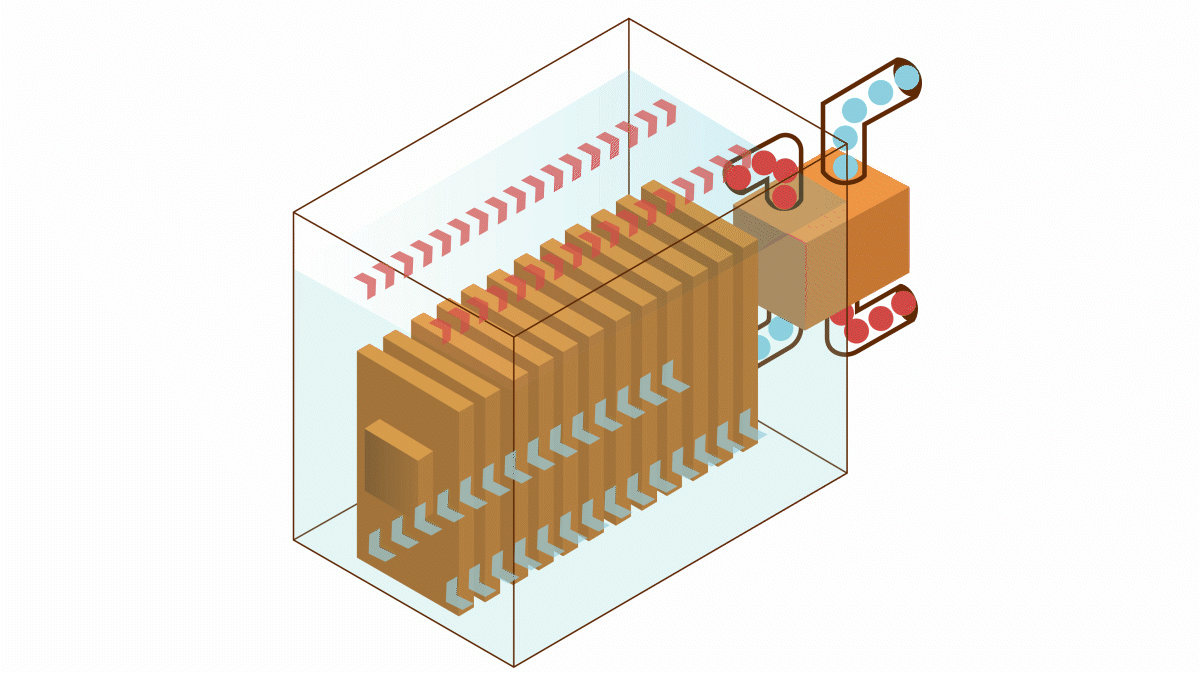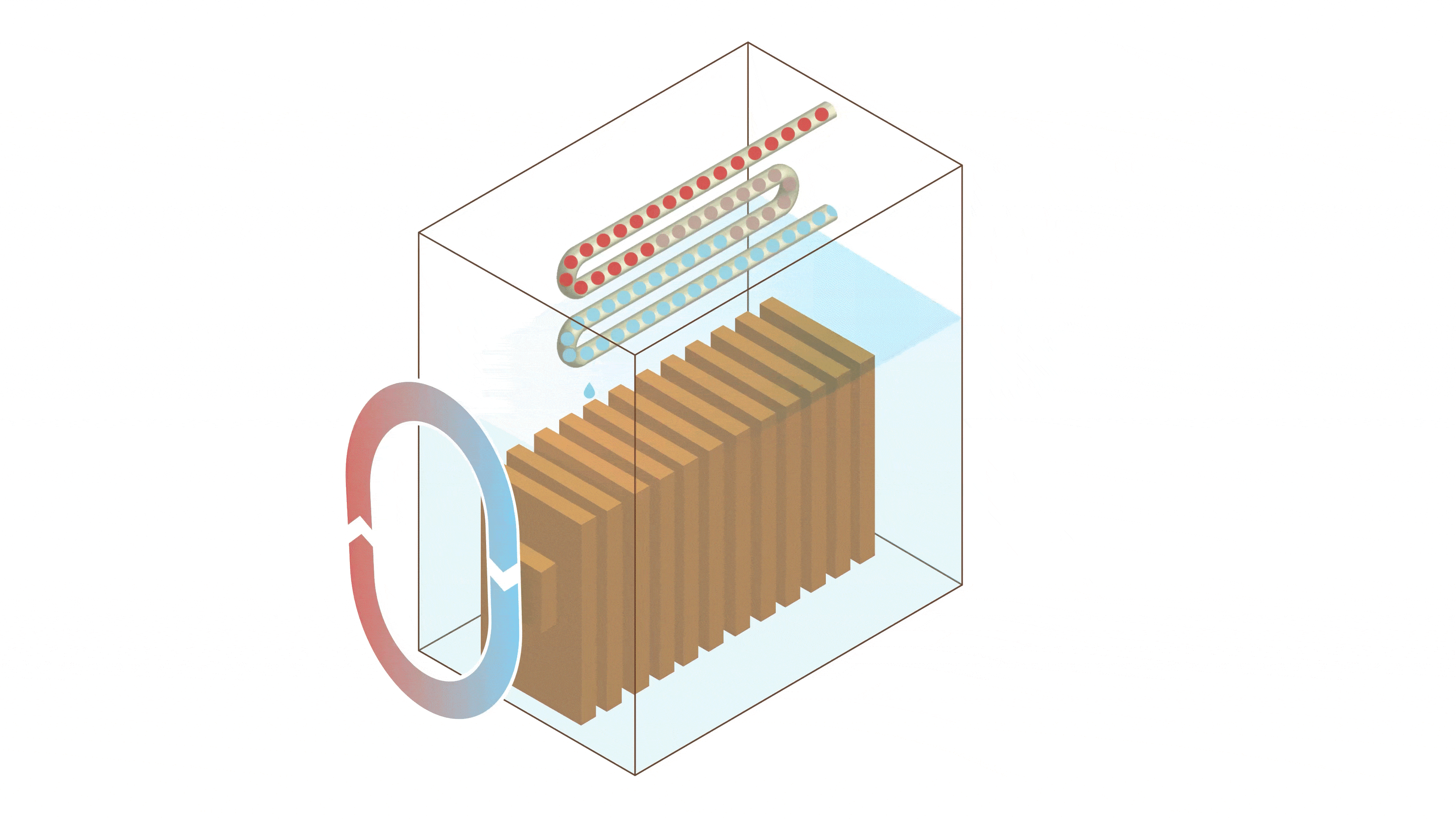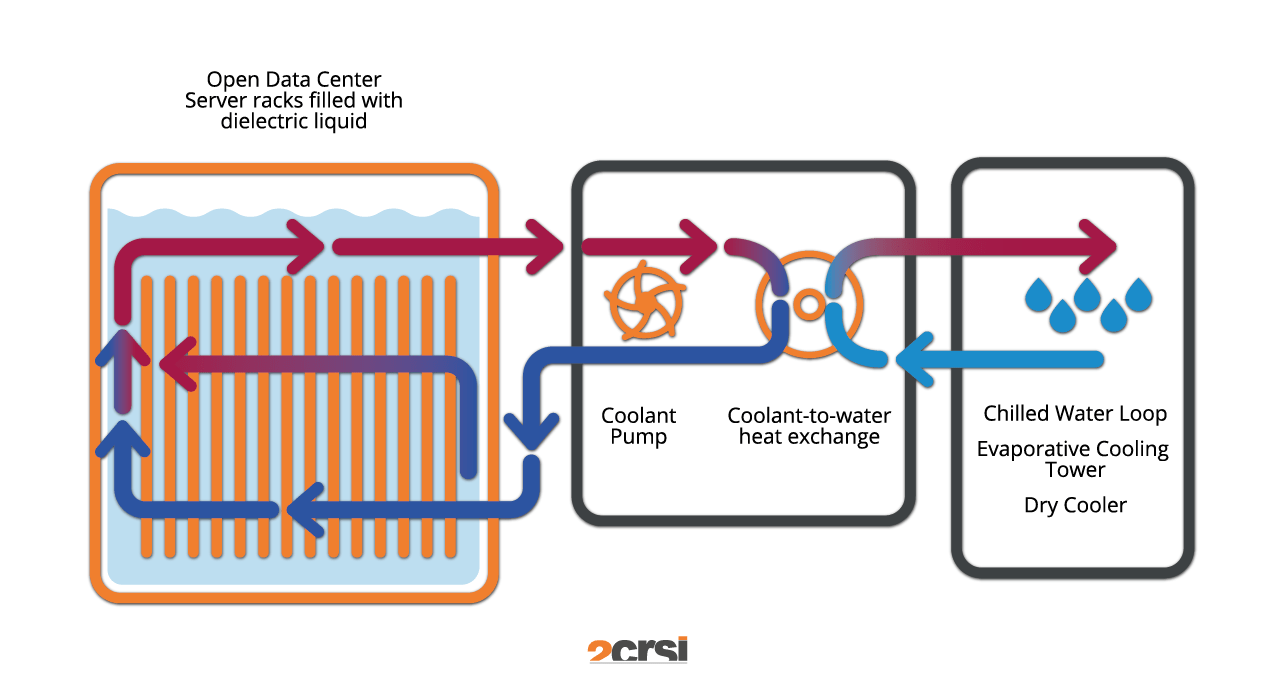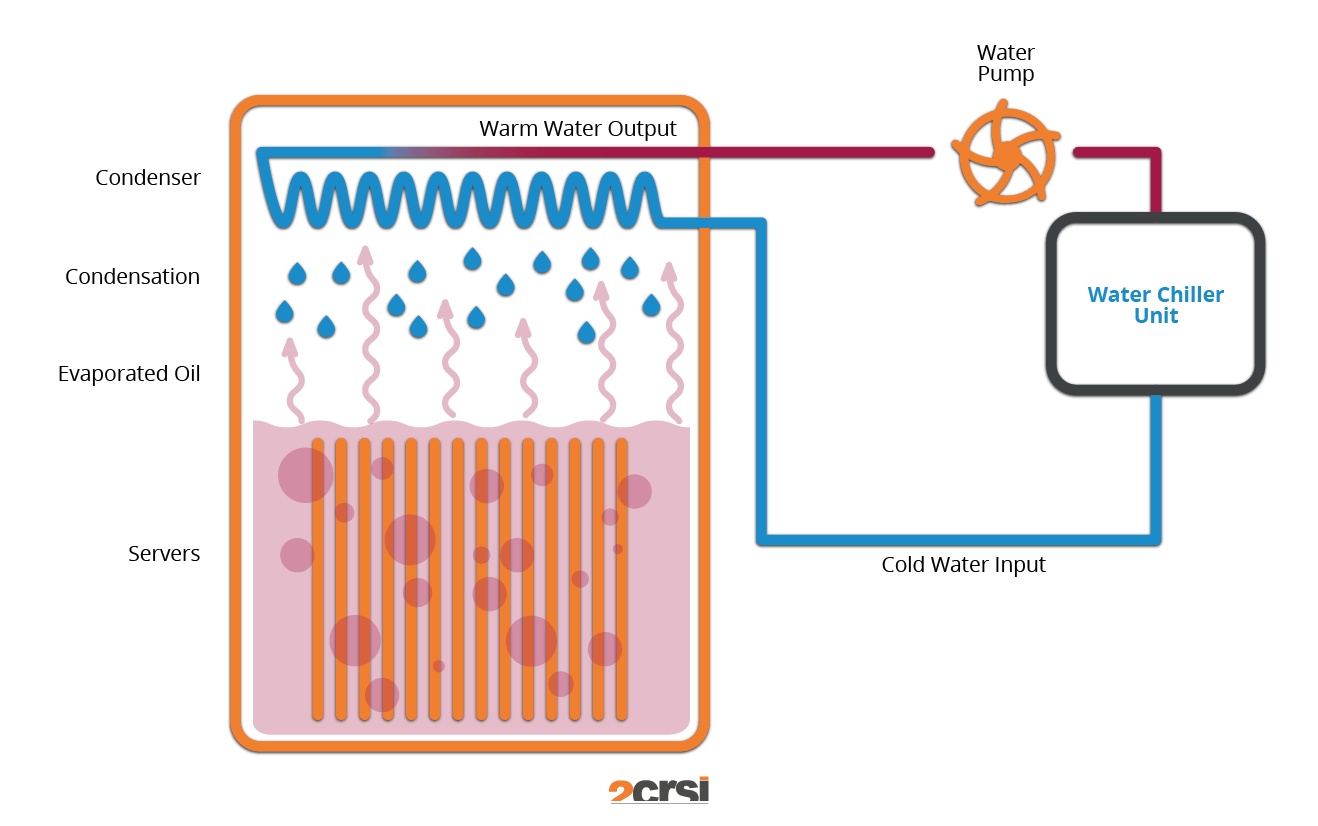IMMERSION COOLING
How Does Immersion Cooling Work?
Immersion cooling system basically consists in completely submerging a server into a dielectric liquid. This type of liquid does not conduct electricity; therefore, it is totally safe for the electronics components to be emerged without any risk of shortcuts and oxidation.
This way, all waste heat generated by the components is captured by the dielectric liquid inside the tank, which is capable of absorbing around 1500 times more heat than air, for the same volume. The heat then flows to a heat exchanger where it’s cooled by a secondary air to liquid or liquid to liquid heat exchanger to be dissipated or reused.
Why choosing Immersion Cooling?
A data center is a facility composed of many servers, computers, and networks that produce a great amount of heat, called “fatal heat” or “waste heat”. This heat is generated by the Joule conversion of electrical energy into heat. In a data server, all IT component’s energy is converted to heat.
It has been proved that heat is counterproductive for all type of IT equipment and can alter its performance and lifespan. To surmount this issue, datacenters are constantly cooled to must be kept at a stable temperature. In general, the cooling is done by cooling energy-consuming units such as fans, which have a negative impact on the environment in the long run.
Nowadays, environment issues are in the center of every debate. Old cooling techniques are no longer satisfying. What can we do? Shutting down servers is unthinkable, knowing the global data center market growth is expected to be over 2% from 2019 to 2025 and its value to reach $105.6 billion by 2026 (Mordor Intelligence). We also can’t ignore that this industry is expected to consume 20% of the world’s energy supply by 2025 (Danfoss).
These figures prove the importance of new technologies and the urgent need to try to reduce the carbon footprint of data centers worldwide. 2CRSi understood the urgency and work every day to create and develop new methods to cool IT equipment in all type of settings, such as direct on chip cooling or immersion cooling.
Your infrastructure consumes more than 80 kW per rack? You need extreme density, flexibility? An outdoor solution? You wish to cut back on maintenance costs and increase power efficiency? Immersion cooling can be the solution for you.
What Is the Difference Between Single-phase and Two-phase Immersion Cooling?
The terms "single-phase" and "two-phase" refer to the behavior of the dielectric coolant as the servers heat it.
Single-phase immersion cooling
With single-phase immersion cooling , servers are totally submerged vertically in a coolant bath filled with a hydrocarbon-based dielectric liquid. The heat produced is then transferred to the coolant through direct contact with the components. It is then sent to a cooling tower through a cooling distribution unit (CDU) to be cooled and sent back in the tank.
Single-phase immersion cooling system is simple, affordable, easier to manage et needs less maintenance.
Here a summarization of single-phase liquid cooling advantages versus air-cooling:
- Quiet operation
- Lower CAPEX and OPEX (per kW)
- Better TCO (per kW)
- About 10x more heat rejection capacity
- Less space required
- More energy efficiency and sustainability

Two-phase immersion cooling
With two-phase immersion cooling , the servers are sealed into a tank filled with a fluorocarbon-based liquid. This liquid has a low boiling point and the heat generated by the components makes it boil rather easily. The boiling liquid is the core of the two-phase system, as the heat turns the liquid into gas, causing a phase change.
The gas goes through a water-cooled condenser coil, placed into the top of the sealed racks. Inside, the vapor is transformed back into liquid which drips back into the tank to be recycled through the system.
Two-phase system has two downsides: the fluorocarbon-based liquid is expensive and must be handled with care.
Here is a summary of two-phase liquid cooling solution:
- Quiet operation
- Faster builds than air cooling
- Less space requirement (compared to single-phase)
- Lower CAPEX and OPEX (per kW)
- Better TCO (per kW)
- Best efficiency in any form of cooling
- Around 2x more heat rejection capacity (compared to single-phase)
- Waste heat can be reuse

2CRSi’s Range of Servers Designed for Immersion
At 2CRSi, we design and manufacture three immersion server ranges, based on consumer insights. Our solutions can meet different needs, from generic platforms to high density compute and GPU compute applications.
How Effective is Liquid Immersion Cooling?
Compared to other cooling systems such as air cooling, using immersion liquid cooling drastically decreases the total cost of ownership (TCO). In other words, the cost to buy something plus the cost to operate it over its useful life.
- Improves IT hardware’s lifespan by 20%, reducing replacing costs,
- 30% of TCO saving,
- 39% reduction of carbon emissions,
- 91% reduction of water consumption,
- Reduction of noise pollution.
Immersion cooling allows a certain temperature homogeneity compared to other cooling methods thanks to the dielectric fluid. Consequently, the components are not as stressed by sudden temperature changes.
Working conditions can be harsh when dealing with a conventional data center using air cooling. Ambient noise can reach up to 90 decibels, leading to poor and dangerous working conditions. With an immersion cooling system, fans are out of the equation, therefore noise pollution is avoided.
Using immersion cooling in a data center also results in a reduction of carbon emissions up to 39% and of water consumption up to 91%, according to our own research.
Immersion cooling: for which applications?
The great aspect of immersion cooling is that its domain of applications is vast and spread across many industries. The industry requires high-power computing and low latency? Cooling by immersion is the best solution to handle that much data and dealing with the heat produced.
In short: industries like cloud gaming and cloud computing, health, IoT and Edge or surveillance would benefit from servers cooled using an immersion cooling system.
Air Cooling vs Immersion Cooling
Comparison of the water consumption of two data centers
A measure system called WUE (Water Use Efficiency) was created to measure water and energy consumption in data centers. This metric is calculated by dividing data center annual energy source and site water usages (in Liters) by total IT power consumption.
|
|
|
Data Center A Air cooling |
Data Center B Immersion cooling |
|
Electricity
|
Total IT Power Consumption |
4.2 MW |
3.36 MW |
|
|
Total Facility Power
|
5.7 MW
|
3.5 MW |
|
Water |
Daily site water usage |
507 300 L |
43 750 L |
|
|
Energy source water per year
|
94.07 million L
|
57 million L |
|
|
Site Water Usage per year
|
185.16 million L
|
15.97 million L |
|
WUE |
Site WUE |
7.59 L/kWh |
2.48 L/kWh |
Comparison of the carbon footprint of two data centers
Carbon emissions come mainly from the extraction of raw materials and their transformation into electronic components, as well as the electrical production of electricity. As we know, the carbon footprint of each country differs.
In France, 1kWh of electricity is equal to 0.014 kg of CO2. Thanks to nuclear plants, France’s carbon footprint is lesser than the USA, which reaches 0.454 kg of CO2 for 1 kWh of electricity.
Carbon Usage Effectiveness (CUE) is a metric that calculates and determines the amount of carbon gas emitted by a data center daily. It was developed by the Green Grid and adopted around the world. It is calculated by dividing the total CO2 emissions equivalents of the facility’s energy consumption by the total IT energy consumption.
|
|
|
Data Center A Air cooling |
Data Center B Immersion cooling |
|
Electricity |
Capacity |
12 000 servers |
12 000 servers |
|
|
Average Power Consumption (per server) |
350 W |
280 W* |
|
|
Total IT Power Consumption
|
4.2 MW
|
3.36 MW |
|
|
Cooling Overhead |
30%
|
2% |
|
|
Electrical Overhead
|
6% |
1% |
|
|
Effective PUE (Power Usage Effectiveness)
|
1.36 | 1.03 |
|
|
Total Facility Power
|
5.7 MW
|
3.5 MW |
|
|
Energy Consumption per year
|
50 million kWh
|
30.3 million kWh |
|
CO2 |
USA Carbon emissions per year |
22.7 million kgCO2 |
13.8 million kgCO2 |
|
|
FRANCE Carbon emissions per year
|
5.2 million kgCO2
|
3.2 million kgCO2 |
|
CUE |
USA Effective CUE |
0.62 kg CO2/kWh |
0.47 kg CO2/kWh |
|
|
FRANCE Effective CUE
|
0.14 kg CO2/kWh
|
0.12 kg CO2/kWh |
*reduce due to fans removal

